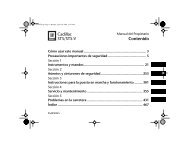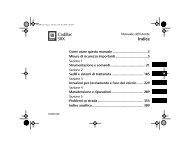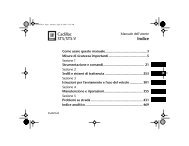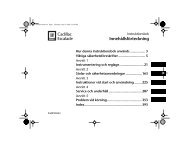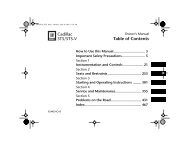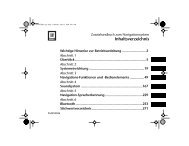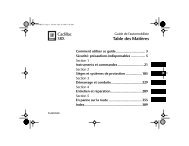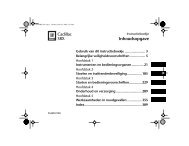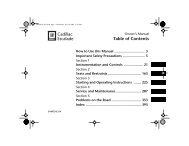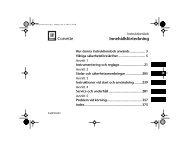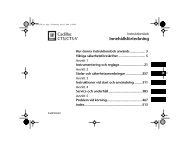Owner's Manual Cadillac BLS - IFS Europe BV
Owner's Manual Cadillac BLS - IFS Europe BV
Owner's Manual Cadillac BLS - IFS Europe BV
You also want an ePaper? Increase the reach of your titles
YUMPU automatically turns print PDFs into web optimized ePapers that Google loves.
460_OM_MY09.book Page 160 Wednesday, April 2, 2008 10:32 AM<br />
160 Starting and driving<br />
Driving in cold climates<br />
In cold weather, special attention should be<br />
paid to the following:<br />
• Before driving off, make sure that the<br />
wiper blades have not frozen to the windscreen.<br />
• Remove any snow from the heating<br />
system air intakes between the bonnet<br />
and the windscreen.<br />
• If necessary, inject oil into the locks to prevent<br />
them from freezing. Use molybdenum-sulphide<br />
oil (MoS 2 ). If the locks<br />
freeze, exercise care when unlocking the<br />
car (manual unlocking) to avoid breaking<br />
the key. Warm up the key or use a de-icer.<br />
• It is particularly important when the roads<br />
are slippery that the brakes and tyres are<br />
in good condition.<br />
• For how to check the level of antifreeze in<br />
the engine coolant, see page 182.<br />
• Add carburettor spirit when refuelling several<br />
times before the onset of winter. This<br />
will prevent condensation water in the fuel<br />
tank from freezing and causing interruptions<br />
in the fuel supply. The likelihood of<br />
condensation is lowest when the fuel tank<br />
is full.<br />
If the car is parked outside and the temperature<br />
is below zero, carburettor spirit is<br />
of little use as it cannot remove water that<br />
has already frozen. Park the car in a warm<br />
place so that any ice that may have built<br />
up melts, then add carburettor spirit when<br />
refuelling.<br />
Condensation is caused by temperature<br />
fluctuations, either in the outside temperature<br />
alone or when the car is alternately<br />
parked outdoors and in a garage.<br />
Cars with diesel engine: Make sure that<br />
you use winter grade fuel. At very low<br />
temperatures, paraffin crystals can<br />
develop in the fuel, which can block the<br />
fuel filter and starve the engine of fuel.<br />
Park the car in a warm place so that the<br />
paraffin crystals melt. See also "Cars with<br />
diesel engine 3" on page 135.<br />
The car is equipped with tyres designed to<br />
provide optimum grip on both wet and dry<br />
roads, although this has been achieved at<br />
the expense of somewhat reduced grip on<br />
snow and ice. For regular driving on snow<br />
and ice, we therefore recommend that<br />
winter tyres be fitted. However, winter tyres<br />
achieve this extra grip at the expense of grip<br />
on bare road surfaces.<br />
Winter tyres, particularly studded tyres,<br />
generally make driving safer on snow and<br />
ice.<br />
Acquaint yourself with the legal provisions<br />
governing the use of different<br />
types of winter tyres and snow chains.<br />
Studded tyres are not allowed in some<br />
countries. If winter tyres are fitted, the<br />
same type must be fitted to all four wheels.<br />
A local workshop will be able to advise you<br />
on suitable tyres for your car. We recommend<br />
that you contact an authorised<br />
<strong>Cadillac</strong> workshop.




